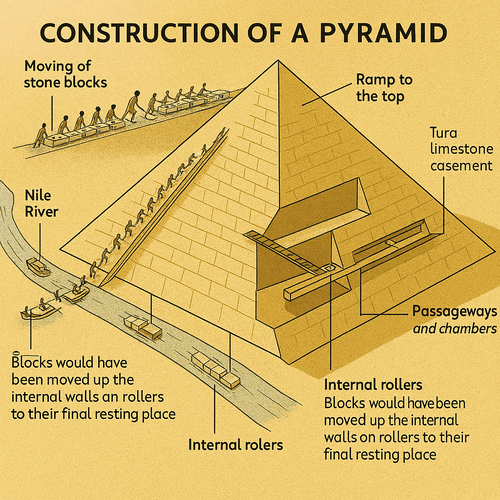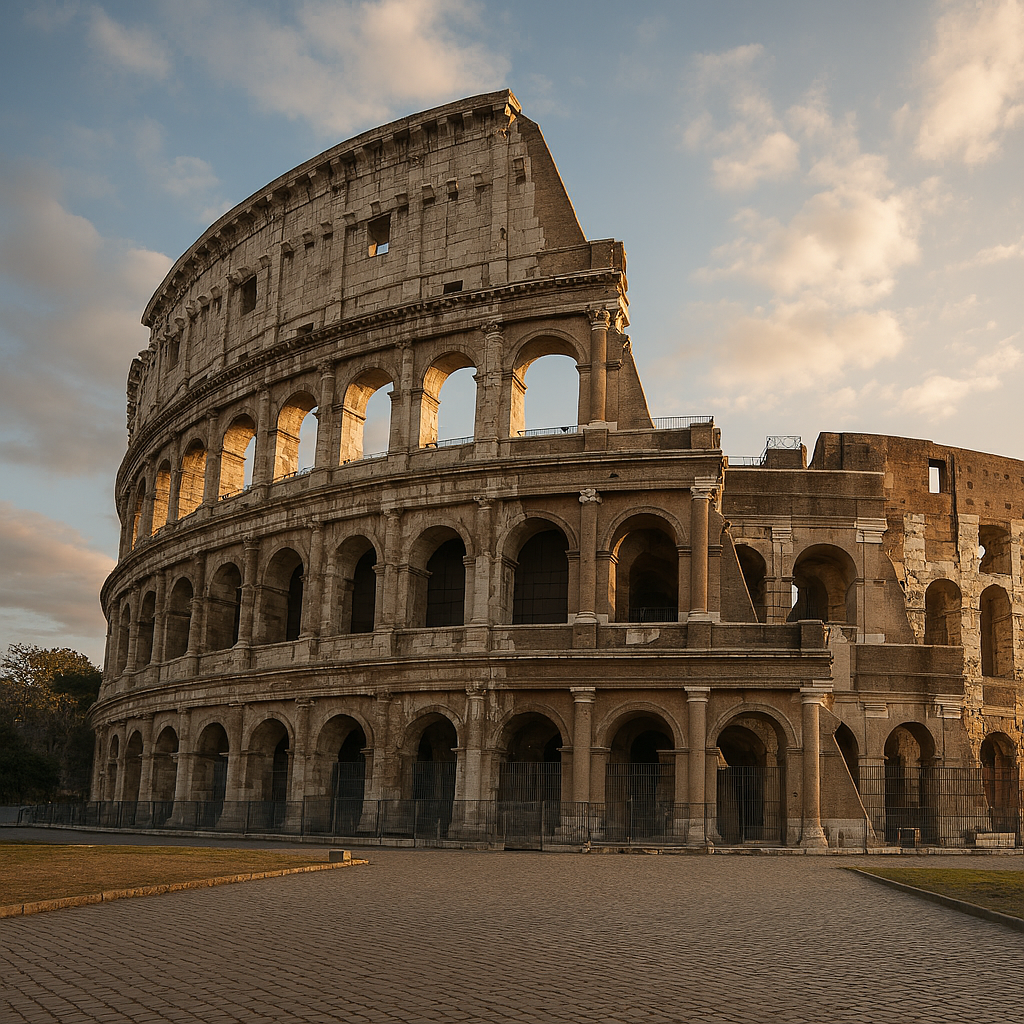Over 4,500 years after its construction, the Great Pyramid remains shrouded in mystery, a captivating puzzle calling to unravel its secrets. It’s the only wonder from ancient times still standing today. Its sheer size and perfect construction leave anyone who sees it amazed. How did humans build such a massive stone structure all those years ago? There are a thousand myths and legends surrounding it. Most of them are not true.
We constantly wonder how the ancient Egyptians built these wonders without modern tools. They had no cranes, no lorries, and no electric drills. Yet they shifted millions of tons of stone with such accuracy. This article is going to look at what actually did go into building these amazing buildings. We will examine what we really do know and what we continue to make guesses about their methods.
We’ll discover who the pyramidal builders were, not slaves. We will learn where they sourced the material. We will also learn how the huge blocks were transported by land and sea. Finally, we will learn what techniques specifically they used to construct the pyramids. Get set to discover the real brilliance of ancient Egypt.
The masterminds and laborers: Who built the pyramids?
The myth that the pyramids were built by slaves is widespread. The picture typically originates from old tales and movies. New evidence informs us about a different truth. Pyramid builders were an upright, well-disciplined team. They worked for their pharaoh and gods. It was a massive project for the whole country.
Debunking the slave labor myth
Archaeologists found ample proof against the myth of slave labor. Dig sites near the pyramids show the workers’ villages. The villages had bakeries, food storages, and even medical centers. Workers were well fed, with meat and fresh bread. Their bones show hard work but also superb health for the era.
Pyramid workers’ graves are close to those of pharaohs. This honor would not have been granted to slaves. Skilled craftsmen and supervisors are also recorded in the inscriptions. They lived in villages like Deir el-Medina. These are indications of a stable, well-supported labor force. They were no drudge laborers working by necessity. They were part of a majestic national endeavor.
The organization of the workforce
It took many hands and wise heads to build a pyramid. The workers were well-organized. There were different levels of command. Professional architects prepared the plans. Foremen supervised the men. Skilled stonecutters carved the blocks. Haulers pulled the heavy blocks. Support workers kept men clothed and fed.
Imagine thousands of workers working together. They lived in the temporary cities near the location. They named groups of workers, like “Friends of Khufu.” This helped with organization. Farmers from many of the most probable likely worked on pyramids during the time the Nile River flooded. Their fields would flood during that time. Building offered them a chance to work for the pharaoh and earn food.
Skills and training of the builders
The pyramid builders had many special skills. Masons trimmed stones to a high precision. Carpenters built ramps, sledges, and tools. Rope makers created durable ropes for pulling and lifting. Surveyors ensured that all was straight and level. These were not simple tasks.
Several skills were passed down from father to son. New apprentice workers were taught by experienced laborers. This way, essential knowledge stayed alive for generations. Pyramids were an art of learning that took a number of years. It was a honorable profession in ancient Egypt. Their abilities added to wonders standing today.
Sourcing the colossal blocks: Quarrying and materials
The Giza pyramids needed millions of blocks of stone. They were not identical. Some had originated from very close places. Others had to be brought hundreds of miles. It was a mammoth task to find them and bring them out of the ground. That was just the beginning of building these massive structures.
The limestone quarries of Giza
The core blocks of the majority of the pyramids were from the plateau of Giza. The local limestone was easily accessible. This local limestone was quarried from pits which were situated almost next to the building site. This avoided a lot of travel time. This core limestone was sufficient to build the majority of the pyramid.
This type of limestone is a soft rock. It was easier to cut than other types of stones. It provided the basic building material. It allowed the workers to get a great deal of blocks in a relatively short period of time. The Giza plateau was a gigantic supply for these builders. They barely had to transport these blocks at all.
Granite from Aswan: The King’s chamber and casing stones
For special work, more dense stone was needed. The King’s Chamber in the Great Pyramid used granite. This heavy, red-colored stone came from the quarries near Aswan. Aswan is about 500 miles south of Giza. Getting these huge granite stones to Giza was a difficult task.
These granite rocks weighed tons per rock. They were utilized for durability and brilliance. Some also propose the outer casing rocks used granite. These would have made the pyramids radiate brilliance. Transferring granite this far demonstrated masterful planning. It was a sheer wonder of ancient logistics.
Quarrying techniques: Tools and methods
Workers used simple but effective tools to cut the stones. For soft limestone, they used copper chisels and wooden mallets. They hammered the chisels on rock cracks. For granite, they used dolerite pounders. These huge, round stones helped smash the granite off the bedrock.
Quarrymen also used a clever trick. Quarrymen cut channels deep into the sides of a block. Then, they made holes in the rock. Dry wooden wedges were inserted into the holes. When the wood became wet, it expanded. This pressure opened up cracks in the rock along faults. This allowed them to break off massive blocks of rock without explosives.
Transporting heavy loads: Moving the mountainous stones
Once quarried, the huge blocks had to be moved. They were moved from quarries to the construction site of the pyramids. This was a process that required innovative ways of moving heavy weights. The Egyptians utilized the power of nature and mere devices in this achievement. It was not an easy feat to move millions of tons of stone.
Thr role of the Nile River
The Nile River was instrumental in the movement of materials. It served as a vast highway for the Egyptians. Aswan granite blocks were transported by boat. Large barges, built to carry heavy loads, pulled these stones north. They floated downstream. This took weeks or months.
Canals were also used. There are speculations that canals were dug close to the Giza plateau. This would allow barges to come even closer to the pyramid construction area. Imagine large boats with granite mooring next to the construction area. The Nile River provided far-away transport for very heavy loads.
Land transportation: Sledges and ropes
As soon as they got off the boats, blocks were moved over land. Labourers placed them onto wooden sledges. Sledges did not have wheels either. Men pulled them using ropes in teams. There are paintings of groups of men pulling a heavy statue on a sledge in the tombs. Someone pours water or milk in front of a sledge. The fluid made the sledge go more smoothly over sand.
Scientific tests confirm this idea. Wet sand reduces friction tremendously. This makes it easier to pull heavy loads. The workers also used levers to shift the blocks. They navigated uneven grounds carefully. Translating stones in such a way needed enormous cooperation and strength.
The mystery of lifting: Ramps and levers
The hardest work was getting the stones up the pyramid. This stage continues to cause lots of controversy among experts. There is no theory that fully accounts for it. But ramps were used for certain. Imagine a massive building site with ramps curling around the pyramid.
One hypothesis is a straight ramp built up against one side. As the pyramid grew larger, so would the ramp have. This ramp would have been enormously long and wide. A second hypothesis is a spiral ramp that wound around the pyramid. This would have been shorter but trickier to deal with corners. A third guess suggests an internal ramp. This ramp would be built inside the pyramid itself. Workers could pull blocks up this hidden way.
Levering systems might have been used for the upper sections also. Workers might have rocked and hoisted up the blocks step by step. They would place wooden props underneath. That would be fine for small blocks way above. The truth could be a mix of these different approaches. All types of ramps have their downsides as well as upsides.
Precision engineering: The art of pyramid construction
The pyramids are not giant piles of stones. They are incredibly precise and well designed. Ancient Egyptian engineers were highly talented in mathematics and astronomy. They were meticulous in all that they did. The result was a work of painstaking planning.
Aligning with the stars: Astronomical precision
The pyramids are practically aligned in the direction of the four cardinal directions. North, South, East, and West are exactly aligned. How did they manage to do it? They likely used stars. They looked at the night sky, which enabled them to find true north. Archaeologist Kate Spence found evidence for this.
Imagine seeing stars like the Big Dipper or Ursa Minor. They could chart their course over the North Star. This enabled them to set an ideal north-south line. This star surveying was very advanced for their time. This shows us how much love they had for the universe.
Leveling the foundation: A flat base
They first had to construct down before constructing up. The Great Pyramid’s foundation is surprisingly level. It is almost flat, within inches over its vast area. How did they create this level surface? One explanation involves water. They could have dug shallow ditches around the foundation. They filled them with water. This would give them an absolute water level line to follow.
Another method was the use of plumb bobs and sighting tools. They marked points on the rock plateau. They dislodged the stone by spading until the whole points were level. The level foundation was essential for the whole structure to remain upright and stable.
The casing stones: A polished sheen
The pyramids once appeared very different. They were covered in smooth, shiny Tura limestone casing stones. They were cut with amazing precision. They fitted together so tightly you could barely find a gap for the blade of a knife. This gave the pyramids a shiny white sheen. Sunlight would have made them shine across the desert.
The majority of these cover stones are lost today. People over time took them away to build other structures. The few remaining exhibit the craftsmanship of the ancient masons. Sharp tools and gritty sands honed the surfaces. This rendered the pyramids stunning to the eye.
Interior chambers and passageways: Intricate design
The inside of the pyramids is just as complex as the outside. The Great Pyramid has elaborate rooms like the King’s Chamber and Queen’s Chamber. There are also narrow, long corridors. The Grand Gallery is a high-sloping corridor. It has a distinctive ceiling made up of enormous, interlocking stones.
Even air shafts were built into the structure. These shafts connect the chambers to the outside. Building these interior spaces required careful planning. Workers had to build voids and supports when building the pyramid. This shows deep thinking and advanced structural expertise.
Modern views and remaining questions
Years later, we still discover new things about the pyramids. Archaeology and science keep giving us a different angle. We may not know everything. But new evidence keeps patching up holes. The more we look, the more we admire these ancient engineers.
Archaeological and scientific investigations
Now, scientists have many different tools that they employ to examine the pyramids. Laser scanning makes 3D models. Ground-penetrating radar examines below the surface. Material analysis informs us about the materials and equipment employed. The ScanPyramids mission has even discovered concealed space. Concealed spaces might be ramps or hidden chambers.
Constant excavations continue to uncover new worker settlements and equipment. These discoveries inform us about everyday life. They also reveal to us how the workers controlled their work. Every new discovery contributes to our knowledge. It enables us to build a more vivid picture of this ancient construction site.
The ingenuity of ancient engineers
The ancient Egyptians were excellent problem solvers. They made the most of what they had. They utilized simple machines like ramps and levers. They understood astronomy and geometry. Their work indicates superior thinking and exceptional resourcefulness. They lacked our technology. Nevertheless, they built buildings that have survived thousands of years.
Their sophisticated expertise about stone and how to move it was distinct. They knew how to organize huge crowds of people. They knew how to work on projects that took decades. Their skill was outstanding. The pyramids are evidence of their creative minds.
Unsolved mysteries and future research
With all our knowledge, there are still some questions unanswered. We don’t know a single perfect solution for every facet of pyramid building. The actual ramp system used remains controversial. How they placed the final capstone is another mystery. We also wonder what tools they used for some of the most beautiful cuts.
Future studies will continue seeking these answers. More emerging technology can uncover additional buried secrets. All of our discoveries bring us nearer to the truth. The pyramids will probably hold some secrets forever. This is part of their enduring wonder.
Conclusion
The pyramids at Giza were not built by slaves. They were built by a well-fed, highly trained, and disciplined workforce. These workers were laboring with pride and purpose. They were creating eternal monuments for their pharaohs. Their labors reflect a definite social order.
Construction of these gigantic structures used a smart mix of methods. Workers quarried stone locally and from far away. They used the Nile River and sledges for transport. Ramps, and perhaps levers, helped to lift the enormous blocks into place. Solutions were simple but very smart.
The precision of the pyramids is just stunning. They show advanced knowledge of astronomy and engineering. Builders oriented them to stars and leveled their bases with exacting care. The flawless joint of casing stones is evidence of their skills. The pyramids are a testament to the greatness of ancient Egyptians. They remind us of human potential and endless possibility.



